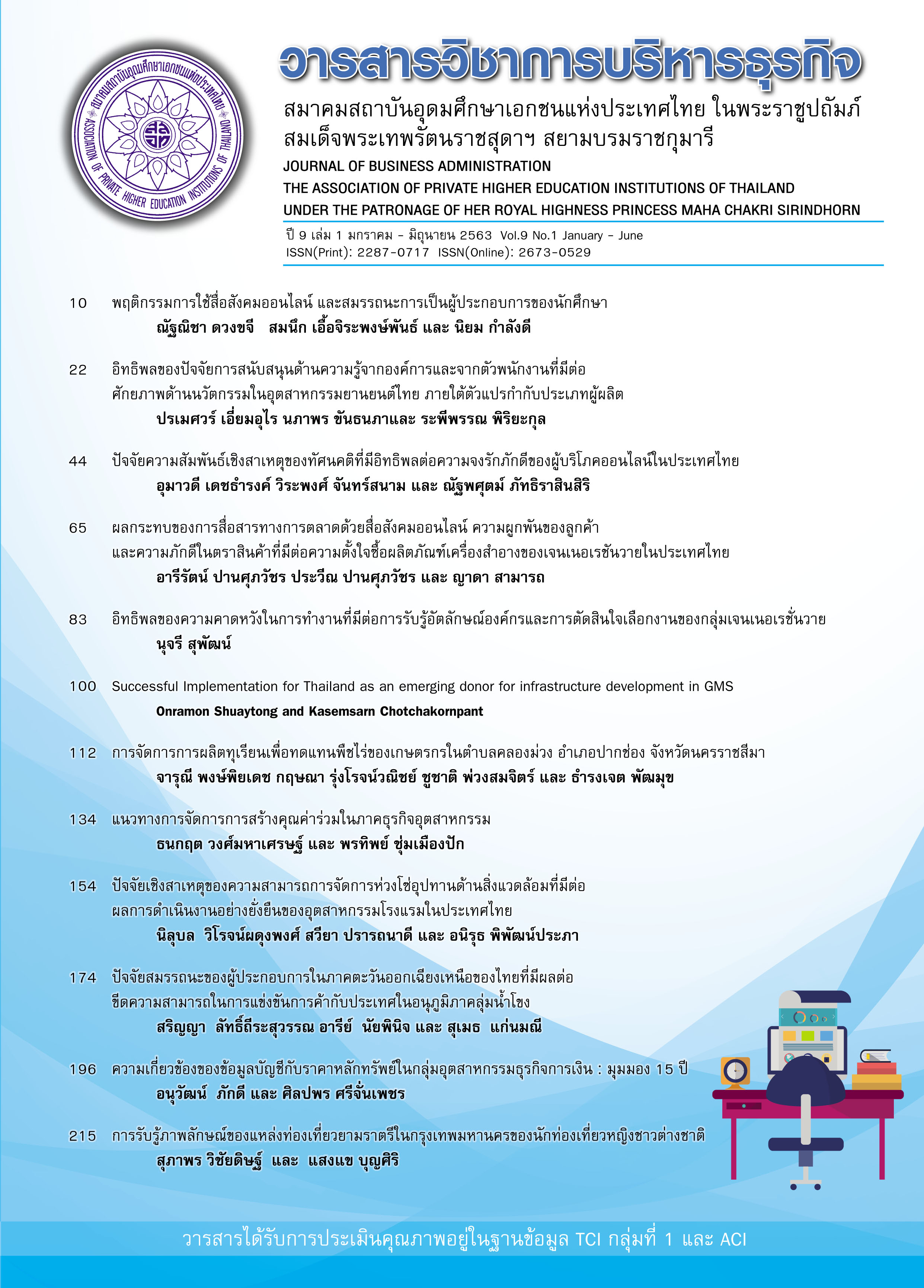ความสeเร็จของประเทศไทยในฐานะประเทศผู้ให้ความช่วยเหลือด้านการพัฒนา โครงสร้างพื้นฐานในอนุภูมิภาคลุ่มแม่น้ำโขง
คำสำคัญ:
การพัฒนาโครงสร้างพื้นฐาน, ความช่วยเหลือทางการเงิน, ความสำเร็จของโครงการอนุภูมิภาคลุ่มแม่น้ำโขงบทคัดย่อ
งานวิจัยนี้มีวัตถุประสงค์เพื่อ (1) ศึกษาปัจจัยที่ส่งผลต่อความสำเร็จในโครงการให้ความช่วยเหลือทางการ
เงินเพื่อการพัฒนาโครงสร้างพื้นฐานในอนุภูมิภาคลุ่มแม่น้ำโขง และ (2) เสนอรูปแบบปัจจัยที่มีอิทธิพลต่อความสำเร็จ
ของโครงการ งานวิจัยนี้เป็นงานวิจัยเชิงคุณภาพ ใช้เทคนิควิธีการเก็บรวบรวมข้อมูล 3 วิธี ประกอบด้วย การวิเคราะห์
เนื้อหา การสังเกตแบบไม่มีส่วนร่วม และการสัมภาษณ์แบบกึ่งโครงสร้างจากผู้ให้ข้อมูลสำคัญจำนวน 34 คน ได้แก่
เจ้าหน้าที่รัฐบาล จำนวน 9 คน เจ้าหน้าที่ส่วนปกครองท้องถิ่นจำนวน 6 คน ผู้แทนท้องถิ่นจำนวน 15 คน และผู้แทน
จาก สาธารณรัฐประชาธิปไตยประชาชนลาว ราชอาณาจักรกัมพูชา และสาธารณรัฐแห่งสหภาพเมียนมา จำนวน
4 คน โดยผู้ให้ข้อมูลสำคัญทั้งหมดเป็นผู้ที่มีส่วนเกี่ยวข้องโดยตรงกับโครงการก่อสร้างถนนใน สาธารณรัฐประชาธิปไตย
ประชาชนลาว ราชอาณาจักรกัมพูชา และสาธารณรัฐแห่งสหภาพเมียนมา
ผลการวิจัยจากการวิเคราะห์เนื้อหา พบว่าเจ้าหน้าที่รัฐบาล นิยามความสำเร็จของโครงการในระดับผลลัพธ์
ประกอบด้วย การยกระดับคุณภาพชีวิต การพัฒนาเศรษฐกิจในอนุภูมิภาค และการสานต่อความร่วมมือกับประเทศ
เพื่อนบ้าน ในขณะที่เจ้าหน้าที่ส่วนปกครองท้องถิ่นและผู้แทนท้องถิ่น นิยามความสำเร็จของโครงการในระดับผลผลิต
ประกอบด้วย การลดระยะเวลาในการเดินทาง การอำนวยความสะดวกการค้าชายแดน ในส่วนของปัจจัยที่ส่งผลต่อ
ความสำเร็จของโครงการ ประกอบด้วย 5 ปัจจัย ได้แก่ (1) มาตรฐานและวัตถุประสงค์ของนโยบาย (2) การประสาน
งานและการมีส่วนร่วมของผู้มีส่วนเกี่ยวข้อง (3) สมรรถนะขององค์กร (4) สภาวะทางสังคมและการเมือง
และ (5) การร่วมมือและบูรณาการกับหุ้นส่วนเพื่อการพัฒนาด้านอื่นๆ ในการวิจัยครั้งนี้ นำเสนอรูปแบบปัจจัยที่มี
อิทธิพลต่อความสำเร็จของโครงการ พบว่าผู้มีส่วนได้ส่วนเสียนิยามความสำเร็จของโครงการในระดับที่ต่างกันส่งผล
ให้เกิดตัวแปรต่อความสำเร็จที่หลากหลาย สำหรับข้อเสนอแนะเชิงนโยบาย ภาครัฐควรส่งเสริมความสัมพันธ์กับ
ประเทศเพื่อนบ้านโดยต้องค�ำ นึงผลประโยชน์ที่ประเทศเพื่อนบ้านพึงได้รับ และควรพัฒนาโคร
เอกสารอ้างอิง
Bhattacharyay, B. N. (2009). Infrastructure development for ASEAN economic integration. ADBI Working Paper 138. Retrieved from https://www.adb.org/sites/default/files/publication/155993/adbi-wp138.pdf
Chen, W. T., Chang, P. Y., & Huang, Y. H. (2010). Assessing the overall performance of value engineering workshops for construction projects. International Journal of Project Management, 28(5), 514-527.
Choi, E. K., & Choi, J. Y. (2007). Infrastructure Aid, Deindustrialization and Urban Unemployment. Staff General Research Papers Archive 12903, Iowa State University, Department of Economics.
Hayman, R. (2006). The complexity of aid: Government strategies donor agendas and the coordination of development assistance in Rwanda 1994-2004 (Doctoral dissertation). University of Edinburgh. Edinburgh.
Kanbur, S. R., Sandler, T., & Morrison, K. M. (1999). The future of development assistance: Common pools and international public goods (Vol. 25). Washington DC: Overseas Development Council.
Kuroda, H. (2007). Infrastructure and regional cooperation. ADBI Discussion Paper No. 76. Retrieved from https://www.adb.org/sites/default/files/publication/156715/adbi-dp76.pdf
Lieber, E. (2009). Mixing Qualitative and Quantitative Method: Insight into Design and Analysis Issue. Journal of Ethnographic & Qualitative Research, 3(4), 218-227.
Mazmanian, D. A., & Sabatier, P. A. (1989). Implementation and public policy (2nd ed.). Glenview Ill: Scott Foresman.
Pressman, J. L., & Wildavsky, A. B. (1973). Implementation: How great expectations in Washington are dashed in Oakland: Or, why it's amazing that Federal programs work at all, this being a saga of the Economic Development Administration as told by two sympathetic observers who seek to build morals on a foundation of ruined hopes. Berkeley: University of California Press.
Roberts, C.W. (2001) Contentanalysis. In N.J. Smelser & P.B. Baltes (Eds.), International encyclopedia of the social and behavioral sciences 9pp.2697-2702). Oxford: Elsevier Science.
Rothbauer, P.M. (2008) Triangulation. In L.M. Given (Ed.), The encyclopedia of qualitative research methods (pp.892-984). New York: Sage
Turner, J. R. (2009). The handbook of project-based management: Leading strategic change in organizations. (3rd ed.). London, U.K.: McGraw-Hill.
Turner, J. R., & Zolin, R. (2012). Forecasting success on large projects: Developing reliable scales to predict multiple perspectives by multiple stakeholders over multiple time frames. Project Management Journal, 43(5), 87-99.
United Nations. (2004). Millennium development goals: Status. New York: United Nations, Department of public Information.
Van Meter, D.S., & Van Horn, C. E. (1975). The policy implementation process: A conceptual framework. Administration and Society, 6(4), 445-488.
World Bank. (2016). Annual report. Washington DC: International Bank for Reconstruction and Development (IBRD) and the International Development Association (IDA).
ดาวน์โหลด
เผยแพร่แล้ว
รูปแบบการอ้างอิง
ฉบับ
ประเภทบทความ
สัญญาอนุญาต
บทความที่ลงตีพิมพ์ในวารสารวิชาการบริหารธุรกิจ สมาคมสถาบันอุดมศึกษาเอกชนแห่งประเทศไทยต้องเป็นบทความที่ไม่เคยได้รับการตีพิมพ์เผยแพร่ หรืออยู่ระหว่างการพิจารณาตีพิมพ์ในวารสารอื่นๆ การละเมิดลิขสิทธิ์เป็นความรับผิดชอบของผู้ส่งบทความโดยตรง


